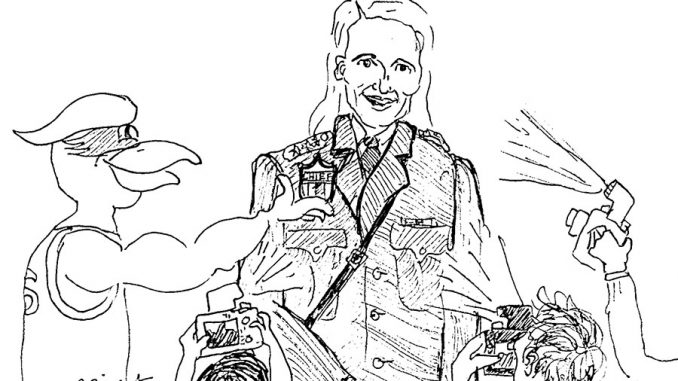
The State University of New York (SUNY) at New Paltz began 2019 by announcing the appointment of Mary Ritayik as Chief of the University Police Department (UPD). Ritayik is the first woman to hold the position in its 50 years, and one of only three females who hold the rank of chief in the entire New York State University Police system.
We at The New Paltz Oracle would like to congratulate Ritayik on her appointment after serving as interim chief since May 2018. Furthermore, we are proud to represent a university that seeks to employ underrepresented groups into leadership positions and that recognizes the hard work done by women such as Ritayik.
Nationwide, however, the gender gap in law enforcement is staggering. According to the Bureau of Justice Statistics, women account for less than 15 percent of local police officers, and only about three percent of local police chiefs.
Ritayik began her career in law enforcement in 1998 at the NYS University Police at SUNY Purchase. She was transferred to SUNY New Paltz in 2000 and shortly after was promoted to University Police Investigator in 2003. Ten years later, she assumed the newly created role of Deputy Chief of Police.
In her time as Deputy and then Interim Chief of Police at New Paltz, Ritayik has helped plan and implement new drills and simulations to educate the campus community and improve officers’ response skills. She also authored the College’s annual Security and Fire Safety Reports.
The leadership gap in law enforcement that Ritayik overcame, unfortunately, is reflected in many fields. Although women earn 60 percent of both undergraduate and master’s degrees, they still lag behind in representation in leadership positions despite holding 52 of all professional-level jobs. Ritayik, for example, is a career law enforcement professional who holds a degree in sociology with a concentration in criminology from SUNY Cortland, and earned the top grade as a graduate of Westchester County Police Academy.
According to the Center for American Progress, women were just 20 percent of executives, senior officers and management in U.S. high-tech industries in 2014. Additionally, as recently as 2016, 43 percent of the 150 highest-earning public companies in Silicon Valley had no female executive officers at all.
Although much progress has been made to address this gender gap in the last few decades, we at The Oracle believe more needs to be done to support the professional advancement of women. Agencies must scout equally qualified candidates of different gender, ethnic and cultural backgrounds in order to support the professional advancement of marginalized groups.
The lack of women in power is not due to a lack of qualified candidates. Interestingly, albeit ranking first in women’s educational attainment on the World Economic Forum’s 2016 Global Gender Gap Index of 144 countries, the U.S. ranks 26th in women’s economic participation and opportunity and 73rd in women’s political empowerment.
In the public sector, regarding female legislators in particular, the United States lags far behind many countries. It will take until 2117 for women to reach parity with men in Congress at the current rate of change. For overall leadership positions in the United States, the estimation for how long it will take women to reach parity with men is 2085.
This figure is alarming for a couple of reasons. First, women have outnumbered men on college campuses since 1988, but the rate of women rising to leadership positions has not followed suit. Second, although the gender wage gap has narrowed and sex segregation in most professions has greatly declined progress has been uneven and particularly parse within the non-white community.
Ritayik has been central to efforts to engender a culture of campus law enforcement and emergency response that is measured, effective, equitable and transparent since her appointment to Deputy Chief of Police in 2013.
“In my career with the New York State University Police, I have come to understand that the unique nuances of campus policing, coupled with the diversity of the campus community, enables members of UPD to progress into insightful and well-rounded officers,” Ritayik said according to a university press release. “I hope my own progression up the ranks to where I am today stands as an example to my new officers that this professional path is attainable and rewarding.”
According to the New Paltz Office of Institutional Research, 61 percent of New Paltz students from 2017 were female. To have the highest law enforcement position reflect the local female population is both comforting and empowering for women on campus.
In addition to UPD’s mission to create and maintain a safe and secure environment that is conducive to the educational mission of the college, UPD also provides service adhering to the guiding principles of respect, education, diversity, commitment, participation and integrity.
According to UPD’s website, diversity is defined as to recognize and appreciate the values each individual brings to the campus. The importance of having a diversified workforce can not be overstated, and to have woman’s, or any member of a marginalized group’s, perspective could provide new ways to observe and approach social issues.
We extend our sincerest congratulations to Ritayik. Furthermore, we commend our university and its police for upholding this value by appointing such a qualified candidate as University Police Chief.
